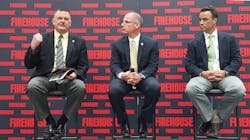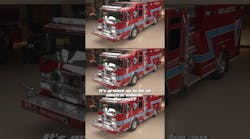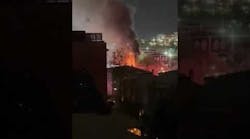SAN DIEGO, Calif. – A debate on fireground tactics occurred on the show floor as two experienced fire officers participated in a moderated panel session at Firehouse World 2016 on Tuesday afternoon.
The debate centered on whether the “hit it hard from the yard” tactic of fire suppression was effective when it comes to saving life and property.
Discussion focused on the science of putting water through a window, or an external attack, versus the tactic of advancing a line through the front door to get to the seat of the fire.
The two panelist were Derek Alkonis, an assistant Los Angeles County Fire Department fire chief and John Salka, a retired FDNY battalion chief.
Firehouse Editor in Chief Tim Sendelbach moderated the session.
“If I am burning in a building, I want the water as soon as possible,” Alkonis said, making an analogy of holding one’s hand over a match and the desire to remove it as quickly as possible. “Every second counts and you want to get out of that situation as quickly as possible.
That’s why he said the immediate, quick hit, cool down of a fire is an effective way of fighting fire.
Salka acknowledged that small rural departments might actually arrive on the scene of a structure fire with only a couple of members could benefit from the the hit it hard from the outside tactic. In that case, it makes perfect sense to put a line to the window with fire blowing out of it to get a quick knock on the blaze.
However, for the most part, well-staffed departments should consider going through the front door advancing the line into the building to find the seat, Salka advocated. He said as fire crews advance through the house, they are more likely to find victims of the fire quickly. Salka described a scenario suggesting it would make no sense to take a line to the back of a structure for a 10-second burst of water and then return it to the front to make an interior attack.
“I am worried about the detouring that will take place,” Salka said. Salka commented that the time it would take to move a line to the back of the structure might be enough time for crews to make it two rooms deep in the structure giving firefighters more time to rescue people who might be trapped inside, waiting for help.
Salka said by the time fire starts rolling out any window, the flashover has already occurred, the condition is no longer tenable as it’s free burning with a window for vent. He said in his opinion it’s always better to fight fire from the unburned to the burned in those cases.
From Alkonis’ perspective, it’s a matter of taking control of a fire as soon as possible to minimize damage to property and to save any victims that may be trapped. One way to do it is with fast water, he said.
“As a room gets ready to flashover ...the fire goes from tenable to untenable,” Alkonis said.
Scientific agencies that test fires, control all aspects of the scenario, from the materials burned, to the size of the structure, flow paths and vents as well as fuel and even the length of time of the burns, Salka said. In the real world, Salka said, firefighters have virtually none of that information and few of the control.
“They start a fire in a box and throw a little bit of water in and say ‘holy sh**, that worked pretty good,’” Salka said.
That comment prompted a response from Robin Zevotek, a research engineer for Underwriters Laboratories working in the Firefighter Safety Research Institute, who happened to be in the audience watching the moderated session.
Zevotek said he was not speaking officially for the UL, but said all the science backs up early water as an effective method for extinguishing fires.
“If you put the fire out, you’re protecting the people inside,” Zevotek said.
Salka countered that even after the fire is extinguished, the life threat is still high with toxic smoke, heat and carbon monoxide levels exceedingly high.
“You’ve got to get in there to save people,” Salka said.
Alkonis said the hit it hard from the yard tactic is just that, a tactic that should be considered.
While the discussion could have continued for hours, Sendelbach closed the session for lack of time and suggested it could be picked up at a later time.
“Folks, the grenade is in the middle of the room,” Sendelbach said.
More from Firehouse World 2016
- Photos: Day 1 - Future Firefighter Program
- FHWorld16: Firehouse Ambassadors Get Lessons in Values
- FHWorld16: Fireground Air Management - A US/UK Perspective
- FHWorld16: Building a Robust Fire Dynamics Training Program
- FHWorld16: The Halligan Is a Valuable Tool on the Fireground
- FHWorld16: Sendelbach Poses Challenge to Fire Service
- FHWorld16: Chief Hood Says It's 'Time to Own It'
- FHWorld16: Leading Health Risks on the Modern Fireground
- FHWorld16: Is 'Hit it Hard from the Yard' Effective?






